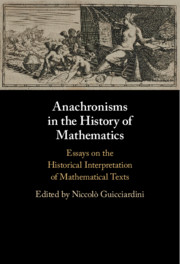 Anachronisms in the History of Mathematics
Anachronisms in the History of Mathematics Book contents
- Frontmatter
- Contents
- Contributors
- Figures
- Preface
- 1 Introduction: The historical interpretation of mathematical texts and the problem of anachronism
- 2 From reading rules to reading algorithms: textual anachronisms in the history of mathematics and their effects on interpretation
- 3 Anachronism and anachorism in the study of mathematics in India
- 4 On the need to re-examine the relationship between the mathematical sciences and philosophy in Greek antiquity
- 5 Productive anachronism: on mathematical reconstruction as a historiographical method
- 6 Anachronism in the Renaissance historiography of mathematics
- 7 Deceptive familiarity: differential equations in Leibniz and the Leibnizian school (1689–1736)
- 8 Euler and analysis: case studies and historiographical perspectives
- 9 Measuring past geometers: a history of non-metric projective anachronism
- 10 Anachronism: Bonola and non-Euclidean geometry
- 11 Anachronism and incommensurability:words, concepts, contexts, and intentions
- Index
5 - Productive anachronism: on mathematical reconstruction as a historiographical method
Published online by Cambridge University Press: 19 July 2021
- Frontmatter
- Contents
- Contributors
- Figures
- Preface
- 1 Introduction: The historical interpretation of mathematical texts and the problem of anachronism
- 2 From reading rules to reading algorithms: textual anachronisms in the history of mathematics and their effects on interpretation
- 3 Anachronism and anachorism in the study of mathematics in India
- 4 On the need to re-examine the relationship between the mathematical sciences and philosophy in Greek antiquity
- 5 Productive anachronism: on mathematical reconstruction as a historiographical method
- 6 Anachronism in the Renaissance historiography of mathematics
- 7 Deceptive familiarity: differential equations in Leibniz and the Leibnizian school (1689–1736)
- 8 Euler and analysis: case studies and historiographical perspectives
- 9 Measuring past geometers: a history of non-metric projective anachronism
- 10 Anachronism: Bonola and non-Euclidean geometry
- 11 Anachronism and incommensurability:words, concepts, contexts, and intentions
- Index
Summary
The spectrum of practises of mathematical reconstruction is explored on the basis of a case study on a partly successful mathematical reconstruction of the Chinese Remainder Theorem. In the 19th century L. Matthiessen reconstructed two versions of this theorem on the basis of a corrupted secondary source concerning ancient Chinese mathematics. He identified the more restricted version of the theorem with a Gaussian approach, whereas the other more general one was described as something new surpassing contemporary mathematical European achievements. I identify and compare two different types of mathematical reconstructions in Matthiessen's contributions, and explore their historiographic functions. To capture the relation between mathematical reconstruction and anachronism, the time scheme in the case study is analyzed and linked to the concept of pluritemporality according to Landwehr. This more complex perspective on the category of time in historical research suggests that anachronism should be re-conceptualized. It allows for a discussion of some of the conditions under which mathematical reconstructions can be used in a historiographically sensitive way in a different setting. I argue that this kind of historiographically sensitive mathematical reconstruction can be regarded as a productive historiographical method
Keywords
- Type
- Chapter
- Information
- Anachronisms in the History of MathematicsEssays on the Historical Interpretation of Mathematical Texts, pp. 131 - 166Publisher: Cambridge University PressPrint publication year: 2021
